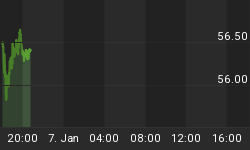Russell Napier's book, Anatomy of the Bear, is a history of the four great stock market buying opportunities of the twentieth century in the United States - the years 1921, 1932, 1949, 1982. The key criteria of each bottom were that stock market averages were at multi-decade inflation adjusted lows, that stocks were selling for as low as 30% of replacement value and that economic news was turning positive. Stock prices at tremendous buying opportunities did not discount good news, but rather they were so depressed that it took good news to make stocks rise. Despite current stock prices at levels that were last seen in the 1990's, the economy is not improving and stocks are not at bargain prices.
Gold, although higher than eight years ago, is still not much higher today than it was in 1980. This compares to the Dow Jones Industrial Average at roughly 8,000 today versus a low of 730 in 1980. Adjusted for inflation, gold is significantly lower today than it was in 1980. Investors who dislike gold argue that it has not risen in 30 years. However, gold at levels seen decades ago should be welcomed by value investors in much the same way as stocks were in the four great buying opportunities mentioned earlier. The news flow is overwhelmingly positive for gold: 1) China and Russia are pushing for a currency to partially replace the Dollar and 2) the Federal Reserve is printing money to buy US Government debt.
We met with a Brazilian company this week and picked up an interesting anecdote that further suggests that holders of US Dollars are backward looking rather than forward looking. This company has been making acquisitions for years, and while the sellers are also Brazilian they want US Dollars. In order to receive Dollars, they accept installment payments over a five year period at a zero percent interest rate. If the selling companies instead accepted Brazilian Real, they would earn double-digit interest rates.
People in other countries also take action to protect their savings by diversifying into multiple currencies. For example, many Turks diversify their income from salaries into Dollars, Euros, gold and other currencies. People do this because they have been conditioned not to trust that their country's currency will retain its purchasing power in light of past hyperinflation.
In contrast to the world's diversification strategy away from domestic currencies, the world is largely concentrated in US Dollars. Not to overstate the obvious, but this is done for perceived safety and preservation of purchasing power. However, in light of the level of debt in the United States, the over ownership of Dollars by individuals and central banks, and the Federal Reserve's intent to "inflate or die," it is clear that the perceived advantage of holding US Dollars is misplaced and loss of purchasing power will result.
US Government officials are downplaying the news flow coming from countries such as China and Russia as the US still believes that it is in the driver's seat. The US, as a borrower, is at the mercy of China and Russia. George Soros made a fortune by shorting the Pound despite the Bank of England's consistent denial that they would devalue the Pound. Of course, eventually it did just that. The US can continue to defend the Dollar and tell the IMF to sell gold, but at some point the markets will realize that the US no longer calls the shots. When that time comes, markets will care about China's recent comments and balk at the United States' rebuttals.
Richard Russell of the Dow Theory says: "The gold bull market, like all bull markets, will do its best to shake us off its back. The gold bull market wants to go up without us. The gold bull market will roar when least expected, after it's worn out many of its followers." Gold is under owned by so many and valued at the same levels it was decades ago. The news for gold is positive.
















